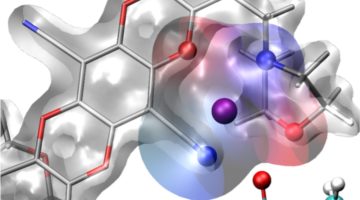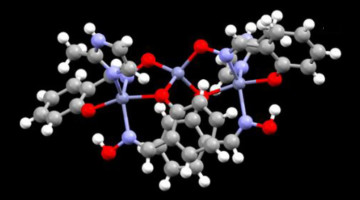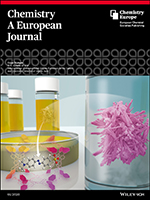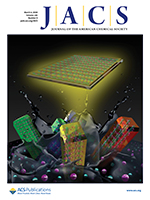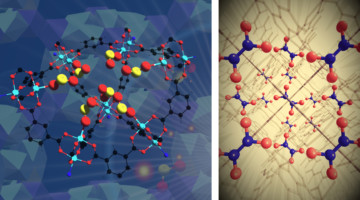Researchers designed a polymer membrane with molecular cages built into its pores that hold positively charged ions from a lithium salt. These “solvation cages” increased lithium-ion flow by an order of magnitude and could allow high-voltage battery cells to operate at higher power and more efficiently, important for both electric vehicles and aircraft. Read more »
Molecular Complex Removes Copper Ions from Water
X-ray analyses provided key insights into the copper uptake mechanisms in a new organic-inorganic hybrid material that quickly and selectively removes copper ions from water. The material provides an efficient tool for copper remediation as well as a blueprint for creating other hybrid materials for removing toxic metals from water. Read more »![]()
![]()
Scientists Design New Framework for Clean Water
A promising solution to water pollution from abandoned copper mines relies on materials that adsorb copper ions from wastewater, but commercially available products lack the required chemical specificity and load capacity. A team of scientists has designed a new crystalline material that targets and traps copper ions from wastewater with unprecedented precision and speed. Read more »
Rational Design of a Uranyl Metal–Organic Framework for the Capture and Colorimetric Detection of Organic Dyes
Diffraction data for a new uranyl-containing metal–organic framework reveals a structure of interpenetrating 3D nets with large pores. The material is stable in aqueous media and due to the large void space (constituting 76% of the unit cell by volume) can sequester organic dyes, the uptake of which induces a visible change to the color of the material. Read more »
Magneto-structural studies of an unusual [MnIIIMnIIGdIII(OR)4]4− partial cubane from 2,2′-bis-p–tBu-calix[4]arene
TBC[4] is a molecular framework that has proven to be a highly versatile ligand for the synthesis of a breadth of polymetallic transition metal, lanthanide metal, and 3d–4f complexes. We outline the synthesis, structure and magnetic behaviour of a new bis-TBC[4]-supported complex, together with theoretical magneto-structural studies examining the exchange interactions. Read more »
Time‐Dependent Cytotoxic Properties of Terpyridine‐Based Copper Complexes
The cover feature picture shows the progressive activation of terpyridine‐based copper(II) compounds that are not cytotoxic against various cell lines after 24 h of incubation but become highly efficient after 72 h of incubation, with IC50 values in the low‐micromolar to nanomolar range. Read more »
Divergent Adsorption-Dependent Luminescence of Amino-Functionalized Lanthanide Metal–Organic Frameworks for Highly Sensitive NO2 Sensors
A novel gas-sensing mechanism exploiting lanthanide luminescence modulation upon NO2 adsorption is demonstrated. Two isostructural lanthanide MOFs are used, including an amino group as the recognition center for NO2. Energy transfer from the ligands to Ln is strongly dependent on the presence of NO2, resulting in an unprecedented photoluminescent sensing scheme. Read more »
Blending Ionic and Coordinate Bonds in Hybrid Semiconductor Materials: A General Approach toward Robust and Solution-Processable Covalent/Coordinate Network Structures
Blending ionic and coordinate bonds in copper iodide based hybrid semiconductor materials with extended covalent/coordinate network structures leads to greatly enhanced solubility and solution processability, making it possible to form high-quality films for device fabrication. Read more »
Turning Up the Heat on Antibacterial-Resistant Diseases
Scientists have designed a biocompatible polymer that has the potential to advance photothermal therapy, a technique that deploys near-infrared light to combat antibacterial-resistant infections and cancer. The team synthesized the polymer by stringing together small molecules called ionic azaquinodimethanes, which they characterized at the ALS. Read more »
Crystallography Reveals How New Molecular Cages Trap Toxic Gases
Current technologies for reducing toxic gas emissions are often ineffective and wasteful. Crystallographic analyses of two new MOF materials revealed how they reversibly bind their target gases, enabling the materials to be reused over many cycles (reducing waste) and permitting subsequent conversion of the gases into valuable chemical products. Read more »
